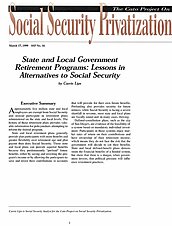State and local retirement plans generally provide plan participants with more benefits and greater flexibility over retirement age and plan payout than does Social Security. Those state and local plans can provide superior benefits because they predominantly “prefund” future benefits, either by saving and investing the program’s income or by allowing the participants to save and invest their contributions in accounts that will provide for their own future benefits. Prefunding also provides security for future retirees: while Social Security is facing a severe shortfall in revenue, most state and local plans are fiscally sound and, in many cases, thriving.
Defined-contribution plans, such as the city of San Diego’s, are evidence of the feasibility of a system based on mandatory individual investment. Participants in those systems enjoy market rates of return on their contributions and have ownership of their retirement income, which means they do not face the risk that the government will decide to cut their benefits. State and local defined-benefit plans demonstrate the financial benefits of a funded system, but show that there is a danger, when government invests, that political pressure will influence investment practices.

